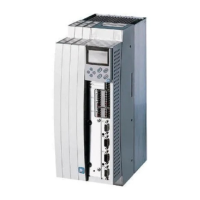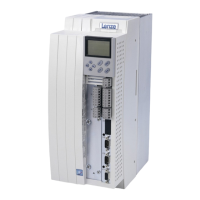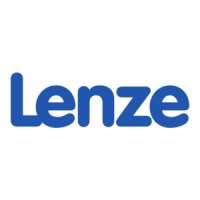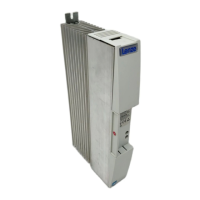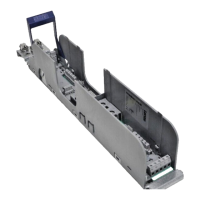Do you have a question about the Lenze 9300 Servo PLC and is the answer not in the manual?
Describes the purpose and scope of the manual for the 9300 Servo PLC.
Explains text and pictogram conventions used for clarity.
Details the meaning of pictograms used for warnings and notes.
Defines key terms like FB, SB, and parameter codes.
Highlights revisions in the current edition of the manual.
Outlines Lenze's Hungarian Notation for consistent variable naming.
Details conventions for creating variable names with prefixes and data types.
Provides guidelines for prefixing variable names with type indicators.
Explains variable name endings (_a, _b, _v, _p) for signal types.
Describes naming conventions for system blocks and variables.
Introduces system blocks (SBs) as quasi-hardware function blocks within the PLC.
Explains accessing SB inputs/outputs using IEC1131-3 absolute addressing (%IXa.b.c, %QXa.b.c).
Lists module numbers assigned to each system block in the 9300 Servo PLC.
Describes how SBs connect to program-organization elements (POEs).
Details the AIF1 SB for input signals from fieldbus modules.
Describes the inputs of the AIF1 SB for setpoint/actual values.
Describes the outputs of the AIF1 SB for setpoint/actual values.
Details the AIF2 SB for input signals from fieldbus modules.
Describes the inputs of the AIF2 SB for setpoint/actual values.
Describes the outputs of the AIF2 SB for setpoint/actual values.
Details the AIF3 SB for input signals from fieldbus modules.
Describes the inputs of the AIF3 SB for setpoint/actual values.
Describes the outputs of the AIF3 SB for setpoint/actual values.
Used for control and monitoring of special AIF-modules (fieldbus modules).
Interface for analog signals via terminal X6/1-2.
Describes analog input 1 for setpoints and parameter control.
Describes analog output 1 used as a monitor output.
Interface for analog signals via terminal X6/3-4.
Describes analog input 2 for setpoints and parameter control.
Describes analog output 2 used as a monitor output.
Operates the drive controller in specific states like TRIP, QSP.
Describes the function to brake the drive to standstill.
Disables starting the drive and resets controllers.
Disables power output stages and resets controllers.
Sets the drive to a specific state and signals "ExternalFault".
Resets an active TRIP if the fault cause is removed.
Reads an existing fault using a system variable, C0168.
Manages the external fault state, changing to TRUE when TRIP-Set is triggered.
Defines binary-coded states of the controller using system variables.
Defines signals output at DCTRL_wStat as a status word.
Explains assignment of control/status words to AIF1_IO/CAN1_IO.
Converts pulse current to speed/phase-angle setpoint.
Details the digital frequency input X9 for TTL level signals.
Provides technical specifications for connecting X9 and X10.
Describes the Touch-Probe function for interval tasks.
Converts internal speed signals to frequency signals for output.
Explains output signals on X10, simulating an incremental encoder.
Describes outputting analog signals [%] as frequency signals at X10.
Describes outputting speed (rpm) signals [%] as frequency signals at X10.
Details encoder simulation for resolvers connected to X7.
Describes using X8 as input for encoders, outputting directly to X10.
Describes using X9 as digital frequency input, outputting directly to X10.
Provides technical specifications for connecting X9 and X10.
Reads digital signals at terminals X5/E1...X5/E5 and conditions them.
Describes the digital inputs of the DIGITAL_IO SB.
Describes the digital outputs of the DIGITAL_IO SB at terminals X5/A1...X5/A4.
Assigns code values directly to variables via a fixed scaling routine.
Contains control functions for the drive, including phase-angle, speed, and motor control.
Details adapting the current controller using parameters C0075 and C0076.
Explains using MCTRL_nMAdd_a as a torque or additional torque setpoint.
Allows setting external torque limits via MCTRL_nLoMLim_a and MCTRL_nHiMLim_a.
Describes the speed controller as an ideal PID controller.
Activates speed restriction using a second speed controller when MCTRL_bNMSwt_b is TRUE.
Restricts speed setpoint in MCTRL_nNSet_a to ±100% of nmax.
Required for phase synchronization and drift-free standstill.
Stops the drive independently of setpoint input within a set time.
Describes automatic or manual field weakening for motor operation.
Allows selection of chopping frequency for the inverter (8 or 16 kHz).
Describes the Touch-Probe function for internal motor control.
Shows the max. speed set under C0011 as a reference value.
Protects the drive from impermissible operating conditions.
Monitors the DC-bus voltage and protects the drive.
Monitors the DC-bus voltage and protects the drive.
Protects the drive controller from earth faults.
Protects the drive controller from short-circuits.
Protects the motor from overheating with a fixed threshold.
Monitors motor temperature with an adjustable threshold.
Protects the motor from overheating via PTC signal.
Illustrates permitted overcurrent over time.
Monitors cable and resolver for wire breakage.
Monitors heatsink temperature with an adjustable threshold.
Monitors heatsink temperature with a fixed threshold.
Monitors plant speed against a maximum limit.
Steers controllers to specified states (TRIP, QSP, inhibit) via a device-specific bus.
Global variables for programming facilitation, including clocks and task info.
Describes the CAN system bus for drive networking.
Details terminal assignments for CAN bus communication on controllers and vectors.
Provides recommendations for system bus cable specifications and basic network structure.
Outlines EMC compliance guidelines for system bus wiring.
Covers technical specifications like baud rates, bus lengths, and communication times.
Specifies communication media and baud rates for the system bus.
Lists possible bus lengths based on data transmission speed.
Explains factors affecting communication times and provides telegram throughput times.
Details steps for commissioning the system bus, including settings.
Explains the programming capabilities offered by the integrated system bus.
Highlights features like parameter entries and data exchange between controllers.
Describes using parameter channels for setting parameters via HMI or PC.
Explains process data channels for high-speed data exchange.
Details system blocks used for CAN communication.
Describes the CAN1_IO SB for cyclic data communication.
Details the inputs of the CAN1_IN SB for higher-level control systems.
Details the outputs of the CAN1_OUT SB for higher-level control systems.
Describes the CAN2_IO SB for data exchange between controllers.
Details inputs for data exchange between controllers and terminals.
Details outputs for data exchange between controllers and terminals.
Describes the CAN3_IO SB for data exchange between controllers.
Details inputs for data exchange between controllers and terminals.
Details outputs for data exchange between controllers and terminals.
Manages CAN bus settings, errors, and reset nodes.
Synchronizes control program cycles with a higher-level control.
Details CAN synchronization via sync telegram or terminal signal.
Demonstrates setting up communication between drive controllers.
Describes the programming steps for the application example.
Explains system bus codes for baud rate, master definition, and addressing.
Configures the baud rate for the system bus.
Sets a drive controller as master for initialization.
Sets addressing for data objects and parameter channels.
Allows individual addressing of process-data objects.
Displays identifiers calculated from basis identifier and address.
Adjusts times for data exchange and CAN output cycle times.
Provides codes to observe events on the bus system.
Monitors telegram arrival within defined times and bus off states.
Describes the CAL-based communication profile DS 301 (CANopen).
Explains identifier and user data structure in CAN telegrams.
Details how identifiers are derived from addresses for drive communication.
Explains the three states: Initialisation, Pre-Operational, Operational.
Explains parameterization using separate software channels and telegram structures.
Demonstrates writing a parameter value via parameter channel.
Demonstrates reading a parameter value via parameter channel.
Describes process-data objects (PDOs) for rapid data exchange.
Details PDOs for rapid cyclical data communication.
Describes PDOs for event-controlled data communication.
Summarizes PLC capabilities, inputs, outputs, memory, and functions.
Lists and describes System POUs and their features.
Explains monitoring functions for system interfaces, memory, and controller parts.
Describes possible reactions (TRIP, Warning, OFF) to monitoring functions.
Overviews fault sources, meanings, and corresponding reactions.
Describes the function block for transmitting error messages to the PLC.
Guides on recognizing and analyzing faults using display elements and history buffer.
Explains using the history buffer to trace faults and their occurrences.
Details the structure of the history buffer and its memory units.
Provides instructions on how to read and reset fault messages from the history buffer.
Lists error codes, their causes, and recommended remedies.
Describes measures for re-commissioning after faults occur.
Explains how to read the code table and lists temporary codes.
An alphabetical index of topics covered in the manual.
Describes the purpose and scope of the manual for the 9300 Servo PLC.
Explains text and pictogram conventions used for clarity.
Details the meaning of pictograms used for warnings and notes.
Defines key terms like FB, SB, and parameter codes.
Highlights revisions in the current edition of the manual.
Outlines Lenze's Hungarian Notation for consistent variable naming.
Details conventions for creating variable names with prefixes and data types.
Provides guidelines for prefixing variable names with type indicators.
Explains variable name endings (_a, _b, _v, _p) for signal types.
Describes naming conventions for system blocks and variables.
Introduces system blocks (SBs) as quasi-hardware function blocks within the PLC.
Explains accessing SB inputs/outputs using IEC1131-3 absolute addressing (%IXa.b.c, %QXa.b.c).
Lists module numbers assigned to each system block in the 9300 Servo PLC.
Describes how SBs connect to program-organization elements (POEs).
Details the AIF1 SB for input signals from fieldbus modules.
Describes the inputs of the AIF1 SB for setpoint/actual values.
Describes the outputs of the AIF1 SB for setpoint/actual values.
Details the AIF2 SB for input signals from fieldbus modules.
Describes the inputs of the AIF2 SB for setpoint/actual values.
Describes the outputs of the AIF2 SB for setpoint/actual values.
Details the AIF3 SB for input signals from fieldbus modules.
Describes the inputs of the AIF3 SB for setpoint/actual values.
Describes the outputs of the AIF3 SB for setpoint/actual values.
Used for control and monitoring of special AIF-modules (fieldbus modules).
Interface for analog signals via terminal X6/1-2.
Describes analog input 1 for setpoints and parameter control.
Describes analog output 1 used as a monitor output.
Interface for analog signals via terminal X6/3-4.
Describes analog input 2 for setpoints and parameter control.
Describes analog output 2 used as a monitor output.
Operates the drive controller in specific states like TRIP, QSP.
Describes the function to brake the drive to standstill.
Disables starting the drive and resets controllers.
Disables power output stages and resets controllers.
Sets the drive to a specific state and signals "ExternalFault".
Resets an active TRIP if the fault cause is removed.
Reads an existing fault using a system variable, C0168.
Manages the external fault state, changing to TRUE when TRIP-Set is triggered.
Defines binary-coded states of the controller using system variables.
Defines signals output at DCTRL_wStat as a status word.
Explains assignment of control/status words to AIF1_IO/CAN1_IO.
Converts pulse current to speed/phase-angle setpoint.
Details the digital frequency input X9 for TTL level signals.
Provides technical specifications for connecting X9 and X10.
Describes the Touch-Probe function for interval tasks.
Converts internal speed signals to frequency signals for output.
Explains output signals on X10, simulating an incremental encoder.
Describes outputting analog signals [%] as frequency signals at X10.
Describes outputting speed (rpm) signals [%] as frequency signals at X10.
Details encoder simulation for resolvers connected to X7.
Describes using X8 as input for encoders, outputting directly to X10.
Describes using X9 as digital frequency input, outputting directly to X10.
Provides technical specifications for connecting X9 and X10.
Reads digital signals at terminals X5/E1...X5/E5 and conditions them.
Describes the digital inputs of the DIGITAL_IO SB.
Describes the digital outputs of the DIGITAL_IO SB at terminals X5/A1...X5/A4.
Assigns code values directly to variables via a fixed scaling routine.
Contains control functions for the drive, including phase-angle, speed, and motor control.
Details adapting the current controller using parameters C0075 and C0076.
Explains using MCTRL_nMAdd_a as a torque or additional torque setpoint.
Allows setting external torque limits via MCTRL_nLoMLim_a and MCTRL_nHiMLim_a.
Describes the speed controller as an ideal PID controller.
Activates speed restriction using a second speed controller when MCTRL_bNMSwt_b is TRUE.
Restricts speed setpoint in MCTRL_nNSet_a to ±100% of nmax.
Required for phase synchronization and drift-free standstill.
Stops the drive independently of setpoint input within a set time.
Describes automatic or manual field weakening for motor operation.
Allows selection of chopping frequency for the inverter (8 or 16 kHz).
Describes the Touch-Probe function for internal motor control.
Shows the max. speed set under C0011 as a reference value.
Protects the drive from impermissible operating conditions.
Monitors the DC-bus voltage and protects the drive.
Monitors the DC-bus voltage and protects the drive.
Protects the drive controller from earth faults.
Protects the drive controller from short-circuits.
Protects the motor from overheating with a fixed threshold.
Monitors motor temperature with an adjustable threshold.
Protects the motor from overheating via PTC signal.
Illustrates permitted overcurrent over time.
Monitors cable and resolver for wire breakage.
Monitors heatsink temperature with an adjustable threshold.
Monitors heatsink temperature with a fixed threshold.
Monitors plant speed against a maximum limit.
Steers controllers to specified states (TRIP, QSP, inhibit) via a device-specific bus.
Global variables for programming facilitation, including clocks and task info.
Describes the CAN system bus for drive networking.
Details terminal assignments for CAN bus communication on controllers and vectors.
Provides recommendations for system bus cable specifications and basic network structure.
Outlines EMC compliance guidelines for system bus wiring.
Covers technical specifications like baud rates, bus lengths, and communication times.
Specifies communication media and baud rates for the system bus.
Lists possible bus lengths based on data transmission speed.
Explains factors affecting communication times and provides telegram throughput times.
Details steps for commissioning the system bus, including settings.
Explains the programming capabilities offered by the integrated system bus.
Highlights features like parameter entries and data exchange between controllers.
Describes using parameter channels for setting parameters via HMI or PC.
Explains process data channels for high-speed data exchange.
Details system blocks used for CAN communication.
Describes the CAN1_IO SB for cyclic data communication.
Details the inputs of the CAN1_IN SB for higher-level control systems.
Details the outputs of the CAN1_OUT SB for higher-level control systems.
Describes the CAN2_IO SB for data exchange between controllers.
Details inputs for data exchange between controllers and terminals.
Details outputs for data exchange between controllers and terminals.
Describes the CAN3_IO SB for data exchange between controllers.
Details inputs for data exchange between controllers and terminals.
Details outputs for data exchange between controllers and terminals.
Manages CAN bus settings, errors, and reset nodes.
Synchronizes control program cycles with a higher-level control.
Details CAN synchronization via sync telegram or terminal signal.
Demonstrates setting up communication between drive controllers.
Describes the programming steps for the application example.
Explains system bus codes for baud rate, master definition, and addressing.
Configures the baud rate for the system bus.
Sets a drive controller as master for initialization.
Sets addressing for data objects and parameter channels.
Allows individual addressing of process-data objects.
Displays identifiers calculated from basis identifier and address.
Adjusts times for data exchange and CAN output cycle times.
Provides codes to observe events on the bus system.
Monitors telegram arrival within defined times and bus off states.
Describes the CAL-based communication profile DS 301 (CANopen).
Explains identifier and user data structure in CAN telegrams.
Details how identifiers are derived from addresses for drive communication.
Explains the three states: Initialisation, Pre-Operational, Operational.
Explains parameterization using separate software channels and telegram structures.
Demonstrates writing a parameter value via parameter channel.
Demonstrates reading a parameter value via parameter channel.
Describes process-data objects (PDOs) for rapid data exchange.
Details PDOs for rapid cyclical data communication.
Describes PDOs for event-controlled data communication.
Summarizes PLC capabilities, inputs, outputs, memory, and functions.
Lists and describes System POUs and their features.
Explains monitoring functions for system interfaces, memory, and controller parts.
Describes possible reactions (TRIP, Warning, OFF) to monitoring functions.
Overviews fault sources, meanings, and corresponding reactions.
Describes the function block for transmitting error messages to the PLC.
Guides on recognizing and analyzing faults using display elements and history buffer.
Explains using the history buffer to trace faults and their occurrences.
Details the structure of the history buffer and its memory units.
Provides instructions on how to read and reset fault messages from the history buffer.
Lists error codes, their causes, and recommended remedies.
Describes measures for re-commissioning after faults occur.
Explains how to read the code table and lists temporary codes.
An alphabetical index of topics covered in the manual.
